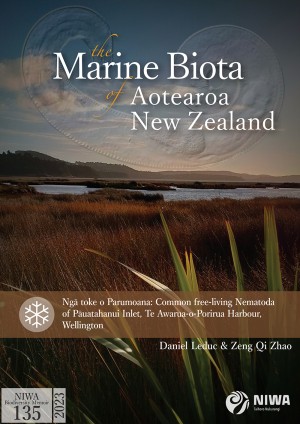
The front cover of The Marine Biota of Aotearoa New Zealand: Ngā Toke o Parumoana: Common free-living Nematoda of Pāuatahanui Inlet, Te Awarua-o-Porirua Harbour, Wellington
Manaaki Whenua nematode systematist Dr Zeng Qi Zhao and NIWA marine nematode taxonomist Dr Daniel Leduc have written a major 212-page book, The Marine Biota of Aotearoa New Zealand: Ngā Toke o Parumoana: Common free-living Nematoda of Pāuatahanui Inlet, Te Awarua-o-Porirua Harbour, Wellington.
Nematodes, or roundworms, are the most numerous and varied animals found in water sediments around the world. In Aotearoa New Zealand (AoNZ) our understanding of these creatures is still very limited, especially in marine sediments. Up until now only 190 species of free-living marine nematodes have been identified in AoNZ’s waters. This research identified 55 different species of nematodes, with 26 new to science.
Zhao and Leduc’s study focused on free-living nematodes in a drowned river valley of Te Awarua-o-Porirua Harbour, near Wellington. This area is ecologically and culturally important, but is affected by land-use changes and pollution. By studying the nematodes here, researchers can better understand and monitor the health of this ecosystem.